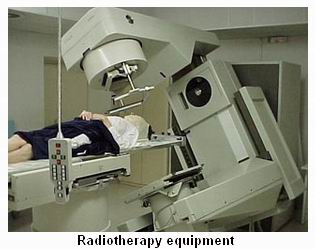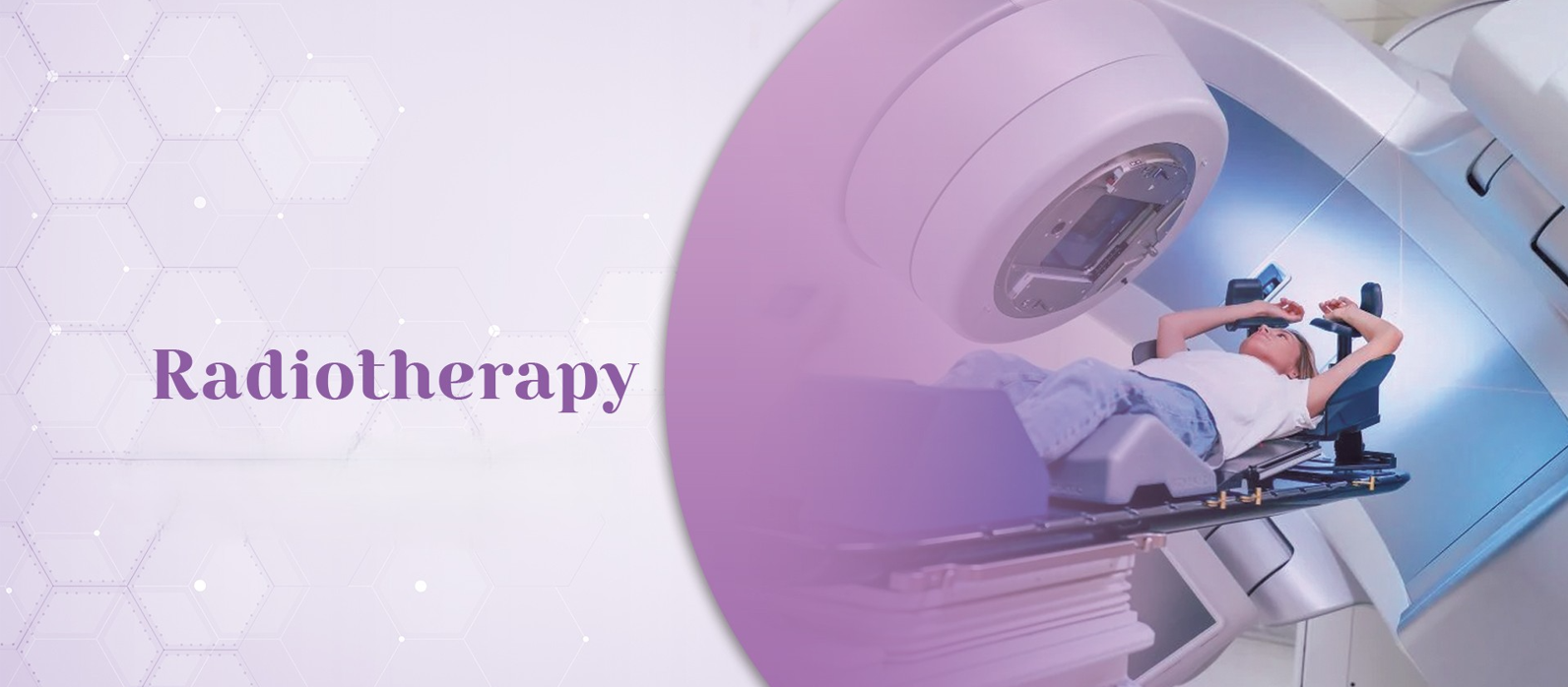
Radiotherapy, also known as radiation therapy, is a treatment that uses high-energy radiation to target and destroy cancer cells. It is commonly used for treating various types of cancer, either as a primary treatment or in combination with other modalities such as surgery, chemotherapy, and immunotherapy.
Radiotherapy works by damaging the DNA within the targeted cancer cells, preventing them from multiplying and growing. The treatment can be delivered in two primary forms: external beam radiation therapy (EBRT), where radiation is directed at the cancer from outside the body, and internal radiation therapy (brachytherapy), where radioactive sources are placed inside or very close to the tumor.
Radiotherapy is a versatile treatment used to cure cancer, shrink tumors before surgery, relieve symptoms of advanced cancer, and improve overall quality of life. The approach taken depends on the cancer's location, type, stage, and the patient's overall health.
This comprehensive guide will cover the causes and risk factors associated with radiotherapy, the symptoms and signs it addresses, diagnostic procedures, treatment options, management strategies, and the complications associated with radiotherapy. It will also discuss how to live with the condition while undergoing radiotherapy.
Radiotherapy itself is not a disease but a treatment method for cancer and other conditions that require targeted radiation. The causes of cancer—conditions treated with radiotherapy—are numerous and vary based on the cancer's location, stage, and the underlying factors that influence cancer development.
Causes of Cancer Treated by Radiotherapy
Cancer occurs when abnormal cells begin to divide uncontrollably. These tumor cells can invade nearby tissues and organs, causing further damage. Radiation therapy is most commonly used to treat cancer, which develops due to genetic mutations, environmental exposure, and lifestyle choices.
Radiotherapy is used to treat various types of cancers, including:
-
Breast Cancer:
-
Radiotherapy is commonly used after breast cancer surgery to reduce the risk of recurrence by targeting remaining cancer cells.
-
-
Lung Cancer:
-
For both small-cell and non-small-cell lung cancers, radiation therapy may be used as part of the treatment regimen.
-
-
Head and Neck Cancer:
-
Radiotherapy is often used to treat cancers in the head and neck region, including oral cancer, throat cancer, and nasal cavity cancer.
-
-
Prostate Cancer:
-
Radiotherapy is used to shrink tumors and treat localized prostate cancer. It can also be used when the cancer has spread to nearby tissues.
-
-
Brain Cancer:
-
Brain tumors are another common target for radiotherapy, especially when surgery is not feasible.
-
-
Cervical and Uterine Cancer:
-
Radiotherapy is used as both an initial treatment and as an adjuvant therapy following surgery.
-
-
Lymphoma and Leukemia:
-
Radiotherapy is frequently used for certain types of lymphoma and leukemia, particularly when other treatments are not effective.
-
Risk Factors for Cancer That May Require Radiotherapy
-
Age:
-
Most cancers that are treated with radiotherapy occur in people over the age of 50. Age-related DNA damage can lead to the development of cancer.
-
-
Genetics:
-
Family history and inherited genetic mutations increase the likelihood of developing certain types of cancer, which may require radiotherapy for treatment. For example, BRCA1 and BRCA2 gene mutations increase the risk of breast and ovarian cancer, while Lynch syndrome increases the risk of colorectal cancer.
-
-
Smoking and Alcohol Use:
-
Tobacco and alcohol consumption are significant risk factors for cancers in the head, neck, lungs, and esophagus. These cancers may require radiotherapy as part of their treatment regimen.
-
-
Exposure to Carcinogens:
-
Exposure to carcinogenic substances like asbestos, chemicals, and radiation increases the risk of various cancers, particularly lung and mesothelioma.
-
-
Immune System Disorders:
-
Conditions like HIV/AIDS or immunosuppressive therapy after organ transplants increase the risk of cancers such as lymphoma, which may require radiotherapy.
-
-
Obesity and Poor Diet:
-
Obesity, a poor diet, and a sedentary lifestyle increase the risk of several cancers, including colon cancer, breast cancer, and endometrial cancer.
-
Radiotherapy itself does not cause symptoms; rather, it is used to treat the symptoms caused by cancer. However, patients undergoing radiotherapy may experience side effects as a result of the treatment.
Symptoms Treated by Radiotherapy
Radiotherapy is primarily used to treat cancer symptoms that may be present in various parts of the body, depending on the type and stage of cancer:
-
Tumor-Related Pain:
-
Radiotherapy is often used to reduce pain caused by tumors pressing against nearby tissues or nerves. For example, patients with bone metastasis may experience severe pain, which can be alleviated with radiation.
-
-
Swelling and Blockages:
-
Radiotherapy helps shrink tumors that cause blockages in organs such as the esophagus, lungs, or bowels, improving the patient's ability to eat, breathe, or pass stool.
-
-
Nausea and Digestive Issues:
-
Radiotherapy is sometimes used to treat cancers in the stomach or intestines, alleviating symptoms like nausea, vomiting, and digestive problems.
-
-
Lymphadenopathy:
-
Radiation can be used to treat enlarged lymph nodes, which often occur in cancers like lymphoma.
-
Common Side Effects of Radiotherapy
-
Fatigue:
-
Fatigue is one of the most common side effects of radiotherapy. Patients may feel extremely tired even after minimal physical activity. This side effect can last for weeks after the treatment ends.
-
-
Skin Irritation:
-
The area of the skin exposed to radiation may become red, itchy, or dry. This condition, known as radiodermatitis, is temporary and usually improves after treatment ends.
-
-
Hair Loss:
-
Patients undergoing radiation to areas such as the head or neck may experience temporary hair loss in the treated area.
-
-
Nausea and Vomiting:
-
Radiation therapy for cancers in the abdomen or pelvis can cause nausea and vomiting, especially in the first few days after treatment.
-
-
Mouth Sores:
-
Radiotherapy for head and neck cancer can cause painful mouth sores or ulcers that make eating, drinking, and speaking difficult.
-
-
Diarrhea:
-
Diarrhea can occur when radiation is directed at the pelvic area, especially in the treatment of colorectal, rectal, or prostate cancers.
-
-
Urinary Issues:
-
Patients receiving radiation to the pelvis may experience urinary frequency, discomfort, or hematuria (blood in the urine).
-
Before starting radiotherapy, an accurate diagnosis of cancer is essential to determine the appropriate treatment plan. The diagnosis of cancer typically involves imaging, biopsy, and blood tests. The treatment plan will depend on the type, stage, and location of the cancer.
Key Diagnostic Tests for Cancer:
-
Imaging:
-
CT scans: CT scans are commonly used to identify and stage cancers, and they help plan the precise delivery of radiation.
-
MRI: Magnetic resonance imaging (MRI) provides detailed images of soft tissues and is used to assess the location of tumors.
-
PET scans: Positron emission tomography (PET) scans are used to detect cancer cells and metastasis.
-
-
Biopsy:
-
A biopsy is required to confirm the presence of cancer and determine the type. This may be done using fine needle aspiration (FNA), core needle biopsy, or surgical biopsy.
-
-
Blood Tests:
-
Blood tests are performed to assess general health, detect tumor markers, and evaluate liver, kidney, and bone marrow function before starting treatment.
-
Radiotherapy is a versatile treatment option used alone or in combination with other cancer treatments like chemotherapy, surgery, and immunotherapy. The exact treatment plan is determined based on the type of cancer, its location, and its stage.
Types of Radiotherapy:
-
External Beam Radiotherapy (EBRT):
-
The most common form of radiotherapy, external beam radiation involves directing high-energy rays from a machine to the tumor from outside the body. The patient usually lies on a treatment table, and the machine adjusts to focus radiation on the tumor.
-
-
Brachytherapy (Internal Radiation):
-
Brachytherapy involves placing radioactive sources inside or very close to the tumor. It is commonly used for cancers of the prostate, cervix, breast, and skin.
-
-
Stereotactic Radiosurgery (SRS):
-
SRS is a precise form of external radiotherapy that delivers very high doses of radiation to a small, well-defined area. It is often used for brain tumors and certain other cancers.
-
-
Proton Therapy:
-
A type of radiation therapy that uses protons rather than X-rays to treat cancer. Proton therapy allows for highly precise targeting of tumors with minimal damage to surrounding healthy tissues. This type of therapy is still being researched and is often used for certain pediatric cancers or tumors near critical organs.
-
-
Intraoperative Radiotherapy (IORT):
-
IORT is a type of radiotherapy given during surgery, typically after the tumor has been partially removed. It is used to target any remaining cancerous cells in the area.
-
While radiotherapy cannot prevent cancer, it plays a significant role in managing cancer and improving the quality of life. Preventive strategies before and after treatment can help manage side effects and enhance the effectiveness of treatment.
Preventive Strategies:
-
Healthy Lifestyle:
-
Eating a healthy diet, exercising regularly, and avoiding smoking and excessive alcohol can help prevent cancer or lower the risk of recurrence.
-
-
Early Detection:
-
Cancer screenings such as mammograms, colonoscopies, and Pap smears are crucial for early detection and effective treatment.
-
-
Protecting Healthy Tissues:
-
Radioprotective drugs, proper shielding, and minimizing radiation exposure to healthy tissues are essential to reducing side effects.
-
Managing Side Effects:
-
Pain Relief:
-
Effective pain management strategies such as medications, acupuncture, and physical therapy can help manage discomfort caused by radiotherapy.
-
-
Nutrition and Hydration:
-
Maintaining a balanced diet and staying hydrated is essential for healing and managing side effects like fatigue and nausea.
-
-
Skin Care:
-
Moisturizing the skin and using recommended creams or lotions can help reduce the discomfort caused by radiodermatitis (skin irritation from radiation).
-
While radiotherapy is an effective treatment, it can cause side effects, both temporary and long-term, especially in cases where large doses of radiation are used or critical areas of the body are treated.
Common Complications:
-
Fatigue:
-
Fatigue is the most common and persistent side effect of radiotherapy. It is important to rest and pace activities during treatment.
-
-
Skin Reactions:
-
Skin irritation, redness, dryness, and peeling can occur in areas treated with radiation. Radiodermatitis is usually temporary and improves after the treatment ends.
-
-
Hair Loss:
-
Hair loss occurs when radiation is directed to the scalp or certain areas of the body, although it is typically temporary.
-
-
Digestive Issues:
-
Radiotherapy aimed at the abdomen or pelvis can cause nausea, vomiting, and diarrhea due to the effects on the digestive system.
-
-
Secondary Cancers:
-
Although rare, radiation therapy may increase the risk of developing secondary cancers in the long term, particularly in younger patients.
-
Living with cancer and undergoing radiotherapy can be physically and emotionally challenging. Support from healthcare professionals, caregivers, and family is essential for maintaining a good quality of life.
Emotional Support:
-
Counseling and psychological support are vital for patients coping with the mental and emotional impact of cancer treatment.
Physical Well-being:
-
Continuing with light physical activities like walking or gentle stretching can help reduce fatigue, improve mood, and prevent complications like muscle wasting.
1. What is Radiotherapy?
Radiotherapy, also known as radiation therapy, is a medical treatment that uses high doses of radiation to kill or damage cancer cells. It works by targeting cancerous tumors with precisely controlled beams of radiation, which can shrink or destroy the tumor. Radiotherapy can also help reduce symptoms of cancer, such as pain or bleeding, especially in advanced stages.
2. How does Radiotherapy work?
Radiotherapy works by damaging the DNA inside cells. When cancer cells are exposed to radiation, it disrupts their ability to divide and grow. While cancer cells are more sensitive to radiation than normal cells, some healthy cells in the treatment area may also be affected. However, the body’s healthy cells can typically repair themselves over time, whereas cancer cells are less likely to recover, leading to their death or damage.
3. What types of cancer can be treated with Radiotherapy?
Radiotherapy is commonly used to treat various types of cancer, including:
-
Breast cancer
-
Lung cancer
-
Prostate cancer
-
Head and neck cancers
-
Brain tumors
-
Cervical cancer
-
Rectal cancer
It can be used as a primary treatment, after surgery to eliminate remaining cancer cells, or alongside chemotherapy to enhance effectiveness.
4. How is Radiotherapy administered?
Radiotherapy can be administered in different ways, depending on the type of cancer and its location:
-
External beam radiation: This is the most common form of radiotherapy, where a machine (linear accelerator) directs radiation beams to the tumor from outside the body.
-
Internal radiation therapy (Brachytherapy): In this method, radioactive material is placed inside the body near the tumor, such as in the prostate or cervix.
-
Systemic radiation therapy: This involves the use of radioactive substances that are injected into the bloodstream or taken orally to target specific cancers, such as thyroid cancer.
5. How long does a Radiotherapy treatment take?
The duration of each radiotherapy session is typically short, often lasting only a few minutes, depending on the type and location of the cancer. However, treatment is usually given over several sessions (typically 5 days a week) over a period of several weeks. The total number of sessions depends on the type of cancer, its stage, and the treatment goals.
6. Is Radiotherapy painful?
Radiotherapy itself is not painful. The process of delivering radiation is similar to having an X-ray taken, and patients do not feel the radiation as it is administered. However, some patients may experience side effects, such as skin irritation, fatigue, or soreness in the treated area, which can be managed by the healthcare team.
7. What are the side effects of Radiotherapy?
Side effects of radiotherapy depend on the area being treated and the type of radiation used. Common side effects include:
-
Fatigue
-
Skin changes (redness, dryness, peeling)
-
Hair loss in the treated area (temporary or permanent)
-
Nausea or vomiting (depending on the area treated)
-
Bladder or bowel changes (such as frequent urination or diarrhea)
-
Mouth or throat sores (if the head or neck area is treated)
Most side effects are temporary and subside after treatment ends. Your doctor will help manage and minimize any side effects.
8. How long will it take to recover after Radiotherapy?
Recovery time after radiotherapy varies depending on the individual and the area being treated. Many side effects, such as fatigue or skin irritation, begin to improve a few weeks after treatment ends. However, some side effects, like fatigue, may last longer. It’s important to follow your healthcare provider’s guidance on rest, nutrition, and activity during recovery.
9. What is the difference between Radiotherapy and Chemotherapy?
Radiotherapy and chemotherapy are both cancer treatments, but they work in different ways:
-
Radiotherapy uses high-energy radiation to target and kill cancer cells in a specific area of the body.
-
Chemotherapy involves the use of drugs to kill cancer cells throughout the body and is typically used for cancers that have spread to multiple areas.
While chemotherapy affects the entire body, radiotherapy is usually more localized to the treated area, leading to different side effects and treatment schedules.
10. Can Radiotherapy be used alongside other cancer treatments?
Yes, radiotherapy can be used in combination with other treatments, such as surgery, chemotherapy, or immunotherapy. It is often used after surgery to target any remaining cancer cells, or alongside chemotherapy to enhance its effectiveness. The combination of treatments is personalized based on the patient’s type of cancer, stage, and overall health, with the goal of achieving the best possible outcome.
The other Oncology Procedures are
Few Major Hospitals for Radiotherapy are
Thailand, Malaysia, Singapore, Turkey and India are the most cost effective locations that offer up to almost 80% savings in comparison to the US.
SurgeryPlanet facilitates a plethora of services to the medical treatment traveler also which includes, a hassle free and discounted travel option, a welcome hand at the airport on arrival, travel in an air-conditioned car, round the clock service & support. Your medical evaluation is pre arranged with the least of waiting time. Once your assessment is complete and found medically fit, the procedure is immediately scheduled without a waiting period. Please read through our Services and Testimonials to understand and select your best options.
Major Treatments Abroad: Obesity / Bariatric Surgery | Spine Surgery | Stem Cell therapy | Fertility treatment | Knee replacement in India and Thailand | Heart Surgery | Organ transplant | ../ayurveda Treatment | Heart valve replacement | Hip resurfacing | Hospitals in India and Thailand for Laparoscopic Sterilization| Best hospitals in Asia | JCI & ISO certified Hospitals | Cost effective medical procedures | Healthcare tourism | Complete privacy for affordable cost | Weight loss procedures | Infertility treatment | Board certified physicians | Low cost surgeries
SurgeryPlanet is an Healthcare Facilitator and not a Medical service provider. The information provided in this website is not to be used for diagnosis or treatment of any medical condition or use for any medical purposes. We provide information solely for medical travel facilitation and do not endorse any particular health care provider, hospital, facility, destination or any healthcare service or treatment listed. We are not an agent for, or affiliated to any health care provider, or service listed in our website and is not responsible for health care services provided by them. Choice of hospital or doctor for your healthcare services is your independent decision. Consult your domestic licensed health care provider before seeking the services of any health care provider you learn about from our website.



